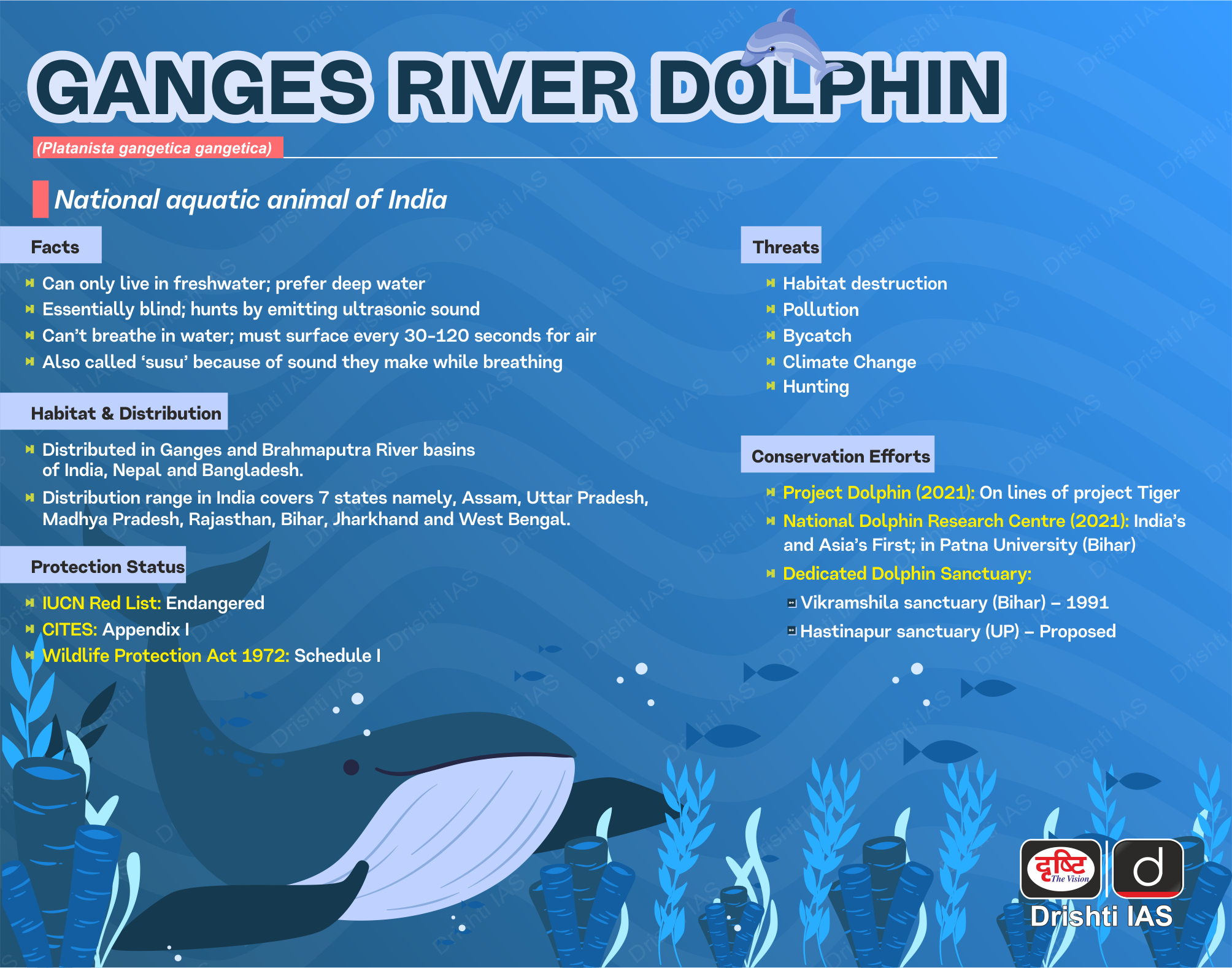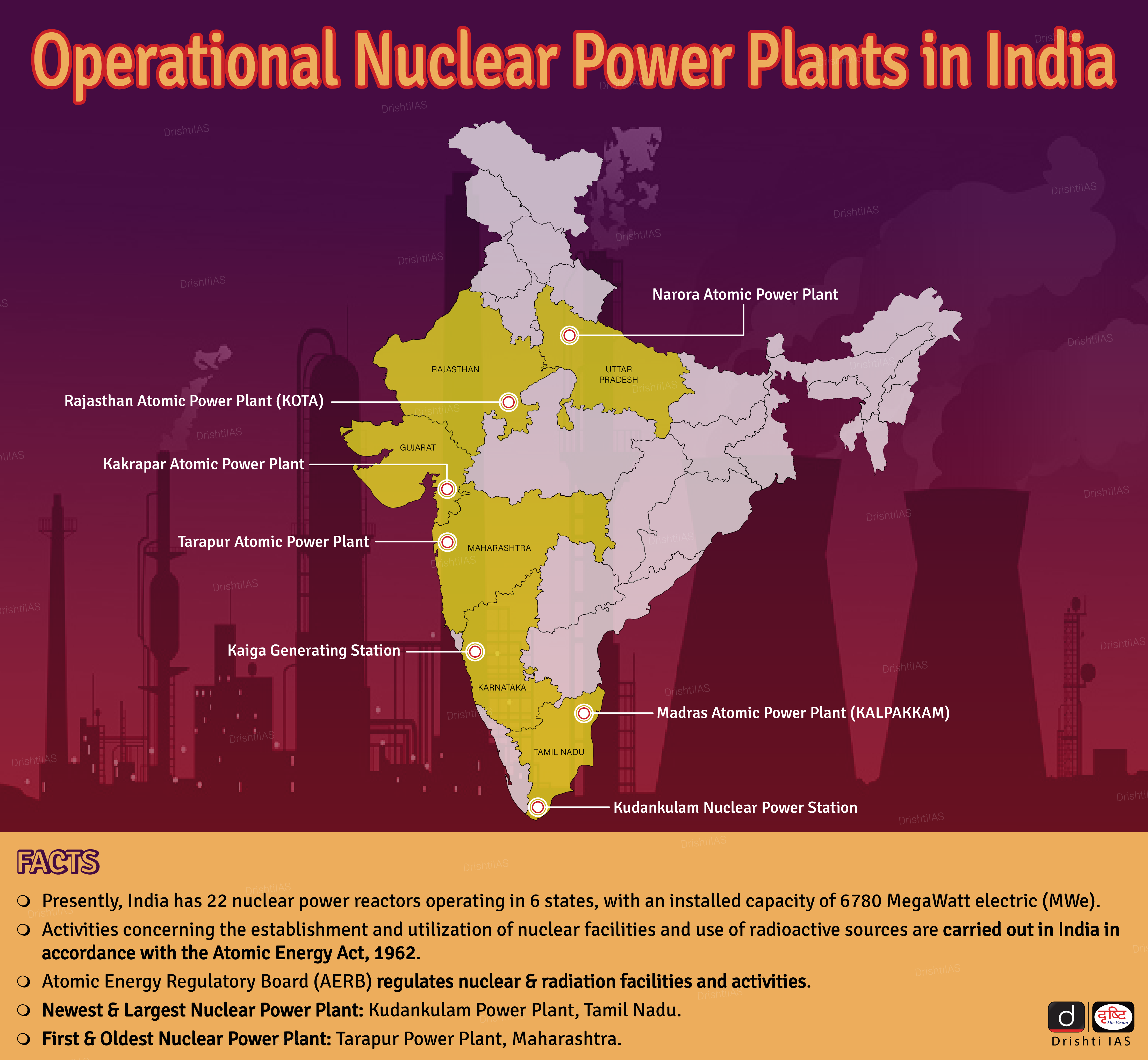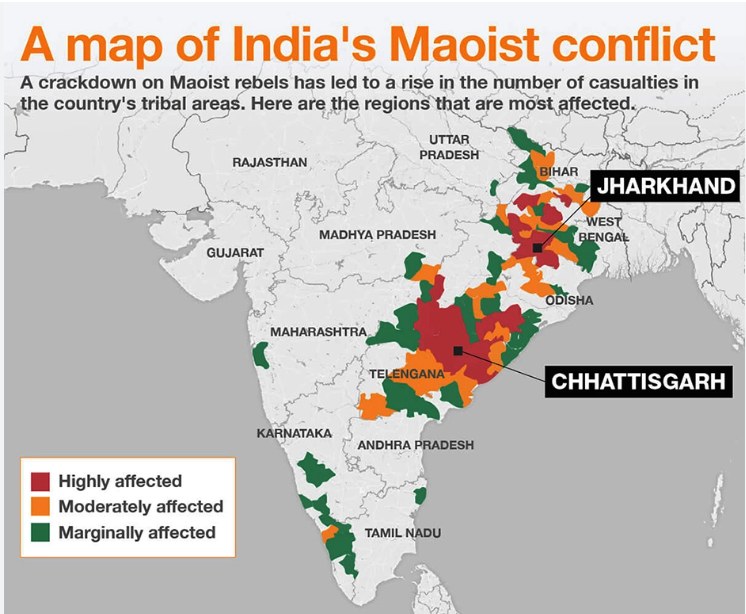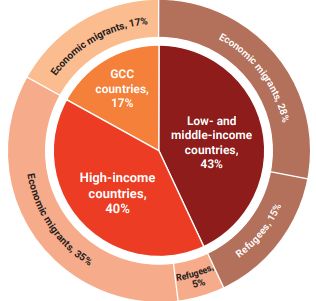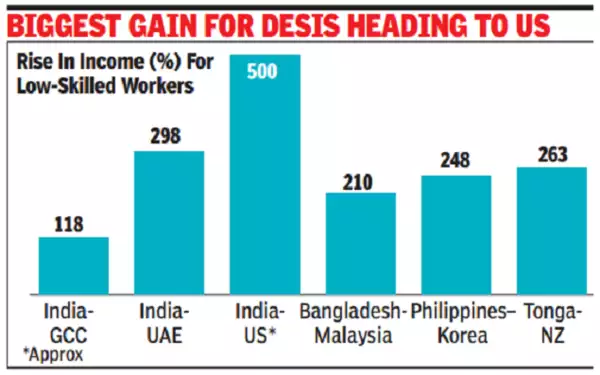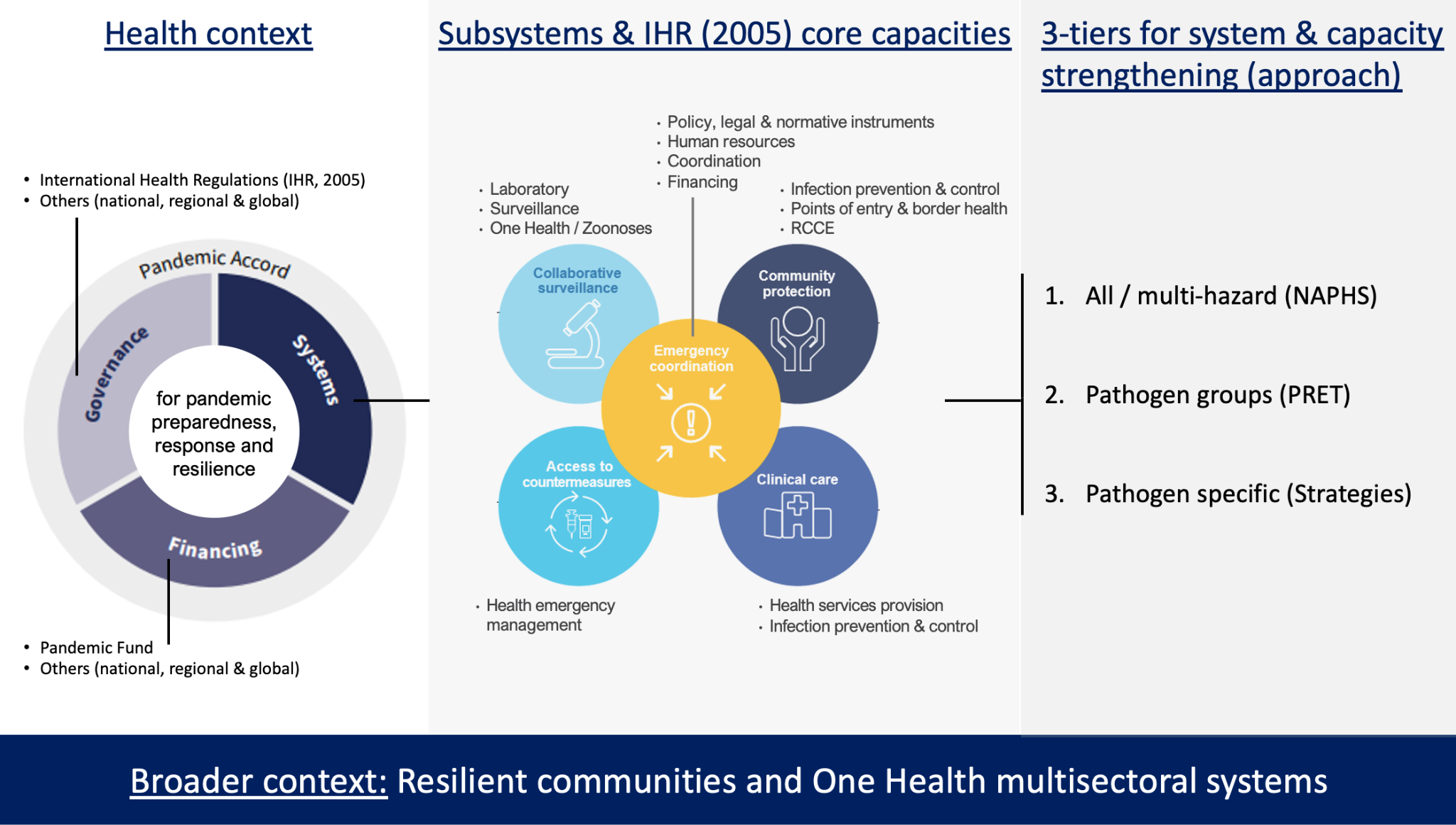Infographics
Science & Technology
Civil Liability for Nuclear Damage Act 2010
For Prelims: Convention on Supplementary Compensation (CSC), Civil Liability for Nuclear Damage Act (CLNDA), 2010, Nuclear Power Corporation of India Limited (NPCIL)
For Mains: Civil Nuclear Liability law: provisions and challenges
Why in News?
The plan to build six nuclear power reactors in Maharashtra's Jaitapur, which is currently the world's biggest nuclear power generation site under consideration, has been delayed for over a decade due to issues related to India's nuclear liability law.
What are the Laws on Civil Nuclear Liability?
- About:
- Laws on civil nuclear liability ensure that compensation is available to the victims for nuclear damage caused by a nuclear incident or disaster and set out who will be liable for that damage.
- International Conventions:
- The IAEA serves as depositary for several international legal instruments on civil liability for nuclear damage, these include the Vienna Convention on Civil Liability for Nuclear Damage and the Convention on Supplementary Compensation for Nuclear Damage.
- The umbrella Convention on Supplementary Compensation (CSC) was adopted in 1997 with the aim of establishing a minimum national compensation amount.
- India has ratified CSC in 2016.
- India’s Civil Liability for Nuclear Damage Act (CLNDA) of 2010:
- Objective:
- India enacted the CLNDA in 2010 to put in place a speedy compensation mechanism for victims of a nuclear accident.
- Liability on Operator:
- The CLNDA provides for strict and no-fault liability on the operator of the nuclear plant, where it will be held liable for damage regardless of any fault on its part.
- It specifies the amount the operator will have to pay in case of damage caused by an accident at ₹1,500 crore.
- It also requires the operator to cover liability through insurance or other financial security.
- Government’s Role:
- In case the damage claims exceed ₹1,500 crore, the CLNDA expects the government to step in.
- It has limited the government liability amount to the rupee equivalent of 300 million Special Drawing Rights (SDRs).
- Supplier Liability Clause: Having realised that the defective parts were partly responsible for the Bhopal gas tragedy in 1984, the govt went beyond the provisions of CSC to provide for supplier liability over and above that of the operator in CLNDA.
- Under this provision, the operator of the nuclear plant can seek recourse from suppliers in the event of a nuclear incident caused by supplier actions, including the supply of equipment or materials with defects, sub-standard services, or the actions of supplier employees.
- Objective:
- Note: The CSC provides for “only” two conditions under which the national law of a country may provide the operator with the “right of recourse”, where they can extract liability from the supplier:
- if it is expressly agreed upon in the contract or
- if the nuclear incident “results from an act or omission done with intent to cause damage”.
Why is the Supplier Liability Clause an Issue in Nuclear Deals?
- Deters Foreign and Domestic Suppliers: Foreign as well as domestic suppliers of nuclear equipment have been wary of operationalizing nuclear deals with India as it has the only law where suppliers can be asked to pay damages.
- Makes Suppliers Vulnerable: The suppliers have raised concerns about potentially getting exposed to unlimited liability under CLNDA as the compensation amount is not fixed under the law as it has been fixed for the operator.
- Moreover, they also have highlighted the ambiguity over how much insurance is to be set aside in case of damage.
- Lack of Clarity involves Other Laws: In the absence of a comprehensive definition on the types of ‘nuclear damage’, the act potentially allows civil liability claims to be brought against the operator and suppliers through other civil laws.
- Attracts Criminal Liability: The Act does not prevent a person from bringing proceedings against the operator under any law other than this Act. It allows criminal liability to be pursued against the operator and the supplier wherever applicable.
What are the Other Issues with CLNDA?
- Monetary Capping on Compensation: The act fixes the liability to a certain monetary limit (for operators: ₹1,500 crore, for government: rupee equivalent of 300 mn SDRs). The biggest problem with such capping is the situations when the damage exceeds the limit.
- The Act does not expressly provide for any provision with respect to cost of damages exceeding the limit.
- Burden on Taxpayers: In India, these plants are state owned and operated through NPCIL and so ultimately the responsibility for such disasters will be borne by common taxpayers.
- Neglect of the Additional Costs: Past incidents such as Chernobyl have shown that the party at fault for a nuclear incident must bear additional costs such as cleaning up and safe disposal of nuclear waste, which are expensive and require caution.
- However, the Act does not provide any provision for these additional costs.
- No Foreign Jurisdiction: India takes supplies from many foreign suppliers which are foreign entities to Indian Law. Indians can’t move to a foreign court to seek compensation.
Way Forward
- Provisions for extra territorial jurisdiction should be made to get access to foreign courts in case compensation is to be sought from a foreign supplier. International Agreements or a robust dispute resolution mechanism could be way out.
- To take suppliers into confidence, a cap on their liability should also be put and a maximum limit on the insurance amount should also be put.
- Law should be amended to resolve the ambiguity and provisions for criminal liability must be eased or scope of criminal proceedings must be clarified.
- Explore alternative funding mechanisms, such as insurance or a dedicated fund, to ensure that the burden is not solely on taxpayers.
UPSC Civil Services Examination, Previous Year Question (PYQ)
Prelims
Q1. Consider the following statements: (2017)
- The Nuclear Security Summits are periodically held under the aegis of the United Nations.
- The International Panel on Fissile Materials is an organ of International Atomic Energy Agency.
Which of the statements given above is/are correct?
(a) 1 only
(b) 2 only
(c) Both 1 and 2
(d) Neither 1 nor 2
Ans: (D)
Q2. In India, why are some nuclear reactors kept under “IAEA safeguards” while others are not? (2020)
(a) Some use uranium and others use thorium
(b) Some use imported uranium and others use domestic supplies
(c) Some are operated by foreign enterprises and others are operated by domestic enterprises
(d) Some are State-owned and others are privately owned
Ans: (b)
Mains
Q1. With growing energy needs should India keep on expanding its nuclear energy programme? Discuss the facts and fears associated with nuclear energy. (2018)
Q2. Give an account of the growth and development of nuclear science and technology in India. What is the advantage of fast breeder reactor programme in India? (2017)


Internal Security
Left Wing Extremism in Chhattisgarh
For Prelims: Left-wing extremism (LWE), Tactical Counter Offensive Campaigns (TCOCs), SAMADHAN Doctrine, Special Infrastructure Scheme (SIS), Greyhounds, Operation Green Hunt.
For Mains: Left-wing extremism (LWE), causes, associated challenges and government initiative to tackle it.
Why In News?
Recently, ten personnel of the Chhattisgarh Police’s District Reserve Guard (DRG) and the civilian driver of their vehicle were reported killed in an IED (Improvised Explosive Device) attack by Maoists in the state’s Dantewada district.
- The attack has took place in Chhattisgarh after more than 2 years when 22 security forces personnel were killed by Maoists in April 2021.
What is Left-wing Extremism?
- About:
- Left-wing extremism (LWE) is a political ideology that advocates for radical socialist, communist, or anarchist ideas and is characterized by the use of violence and terrorism as a means of achieving its goals.
- It often involves opposition to capitalism, imperialism, and the established political and social order, and seeks to establish a revolutionary socialist or communist state.
- Targets:
- LWE groups may target government institutions, law enforcement agencies, or private property to further their agenda.
- LWE is often opposed by governments and law enforcement agencies, who view it as a threat to national security and stability.
- LWE groups may target government institutions, law enforcement agencies, or private property to further their agenda.
What is the LWE Situation in Chhattisgarh?
- Chhattisgarh is the only state in India where Maoists continue to have a significant presence and retain the capability to mount big attacks.
- In the last 5 years (2018-22), Chhattisgarh has accounted for more than 1/3rd of all Maoist-related violence and had a share of 70%-90% of total deaths due to same.
- Chhattisgarh continues to remain troubled. Through the active involvement of state police in Andhra Pradesh, West Bengal, Odisha and Jharkhand, the states were able to end their Maoist problem.
- However, this process of eradicating LWE has started comparatively late in Chhattisgarh and by the time, the police of neighbouring states had already pushed Maoists from their states to Chhattisgarh, making it a concentrated zone of Maoist influence.
- The absence of roads, connectivity and infrastructure and minimal presence of the administration in Bastar has ensured that Maoists continue to have influence in the region and enjoy local support through a mix of fear and goodwill.
What is the Current LWE Situation in the Country?
- According to the government, Maoist violence in the country has gone down by 77% since 2010.
- As per the Ministry of Home Affairs (MHA) the number of resultant deaths (security forces + civilians) has come down by 90% from the all-time high of 1,005 in 2010 to 98 in 2022.
- The influence of Maoists and associated violence has been falling consistently in the country because of multiple factors:
- A stronger push by security forces in Maoist strongholds.
- Roads and civic amenities reach the interior to a greater extent than earlier.
- A general disenchantment with the Maoist ideology among the youth, which has deprived the insurgent movement of new leadership.
What are the Government Initiatives to Control LWE?
- SAMADHAN doctrine is the one-stop solution for the LWE problem. It encompasses the entire strategy of government from short-term policy to long-term policy formulated at different levels. SAMADHAN stands for:
- S- Smart Leadership
- A- Aggressive Strategy
- M- Motivation and Training
- A- Actionable Intelligence
- D- Dashboard Based KPIs (Key Performance Indicators) and KRAs (Key Result Areas)
- H- Harnessing Technology
- A- Action plan for each Theatre
- N- No access to Financing
- National Policy and Action Plan in 2015: It consists of a multi-pronged approach comprising security measures, development initiatives and ensuring rights & entitlements of local communities.
- The MHA is supporting the State Governments extensively by way of deployment of Central Armed Police Force (CAPF) Battalions, provision of helicopters and UAVs and sanction of India Reserve Battalions (IRBs)/ Special India Reserve Battalions (SIRBs) etc.
- Funds are provided under Modernization of Police Force (MPF), Security Related Expenditure (SRE) Scheme and Special Infrastructure Scheme (SIS) for modernization and training of State Police.
- Funds for development are also provided to most LWE affected districts under the Special Central Assistance (SCA) scheme.
- Aspirational Districts Programme: Aspirational Districts Programme launched in 2018, aims to rapidly transform the districts that have shown relatively lesser progress in key social areas.
- Greyhounds: Greyhounds was raised in 1989 as an elite anti-naxal force.
- Operation Green Hunt: Operation Green Hunt was started in 2009-10 and massive deployment of security forces was done in the naxal-affected areas.
- Bastariya Battalion: In Chhattisgarh, the CRPF raised a Bastariya Battalion the recruits for which were taken from the local population, who knew the language and terrain, and could generate intelligence.
- This unit now has 400 recruits and regularly conducts operations in Chhattisgarh.
What are the Challenges in Tackling LWE?
- Wide Geographic Spread: LWE groups operate in remote and inaccessible areas; dense forests, hilly terrains, and where there is lack of proper infrastructure making it challenging for security forces to track them down.
- Support of Local Communities: LWE groups often enjoy the support of local communities who feel neglected and marginalized by the government.
- Lack of Development: LWE affected areas are often underdeveloped, with inadequate access to basic amenities which creates fertile ground for extremist ideologies.
- Political Support: LWE groups often have the support of certain political parties and leaders, who use them for their own interests making it challenging for the government to take a strong stance against them without risking political backlash.
Way Forward
- Socio-Economic Development: The government needs to focus on improving socio-economic conditions in areas affected by left wing extremism such as investing in infrastructure, creating employment opportunities, and providing better access to education and healthcare.
- Targeted Security Operations: The security forces need to conduct targeted operations against LWE groups, using intelligence-based approaches and avoiding collateral damage.
- Rehabilitation and Reintegration: The government needs to provide rehabilitation and reintegration support to former extremists who have renounced violence by providing them with education, training, employment as well as psychosocial support.
UPSC Civil Services Examination, Previous Year Question (PYQ)
Mains
Q. The persisting drives of the government for development of large industries in backward areas have resulted in isolating the tribal population and the farmers who face multiple displacements. With Malkangiri and Naxalbari foci, discuss the corrective strategies needed to win the Left-Wing Extremism (LWE) doctrine that affected citizens back into the mainstream of social and economic growth. (2015)
Buy Now
Biodiversity & Environment
Supreme Court Modifies Order on ESZ
For Prelims: Eco-sensitive Zones, National Wildlife Action Plan (2002-2016).
For Mains: Activities Around ESZs, Significance of ESZs, Challenges Associated with ESZs.
Why in News?
The Supreme Court modified its previous judgment regarding Eco-Sensitive Zones (ESZ) around protected forests, stating that ESZs cannot be uniform across the entire country, and instead need to be tailored to the specific protected area.
What was the Earlier SC Judgement on ESZ?
- Previous Judgement:
- In June 2022, the SC ordered that ESZs of a minimum of one kilometer should be declared around protected forests, national parks, and wildlife sanctuaries across the country.
- The court had said that ESZs would act as a "shock absorber" for the protected areas and prevent encroachment, illegal mining, construction, and other activities that could harm the environment and wildlife.
- The court had also directed the Centre and the States to notify the ESZs within 6 months and file compliance reports.
- In June 2022, the SC ordered that ESZs of a minimum of one kilometer should be declared around protected forests, national parks, and wildlife sanctuaries across the country.
- Arguments by Centre and States for Challenging it:
- The June 2022 order affected hundreds of villages in the peripheries of forests. ESZs cannot be uniform across the country and have to be decided on a case-by-case basis.
- Geographical features, population density, land use patterns, and other factors of each protected area need to be taken into account.
- The order would hamper the development activities and livelihoods of the people living in the ESZs, as well as the conservation efforts of the forest departments.
- The June 2022 order affected hundreds of villages in the peripheries of forests. ESZs cannot be uniform across the country and have to be decided on a case-by-case basis.
What did the SC say in its Modified Order?
- The bench led by Justice B.R. Gavai agreed with the submissions of the Centre and the States and modified its previous order by saying that:
- The purpose of declaring ESZs is not to hamper the day-to-day activities of the citizens but to protect the environment and wildlife.
- A stringent observance of the June 2022 order would cause more harm than good, as it would increase man-animal conflict, prevent basic amenities and infrastructure for the villagers, and hinder eco-development activities around protected areas.
- The Centre and the States should notify ESZs as per their own proposals or as per recommendations of expert committees within 6 months.
- However, mining within the national parks/wildlife sanctuaries and within an area of 1 km from their boundary shall not be permissible.
What are Eco-Sensitive Zones?
- Governing Statute:
- The National Wildlife Action Plan (2002-2016) of the MoEFCC stipulated that state governments should declare land falling within 10 km of the boundaries of national parks and wildlife sanctuaries as eco-fragile zones or Eco-Sensitive Zones (ESZs) under the Environmental (Protection) Act, 1986.
- Extent:
- While the 10-km rule is implemented as a general principle, the extent of its application can vary.
- Areas beyond 10 km can also be notified by the Union government as ESZs, if they hold larger ecologically important “sensitive corridors”.
- Prohibited Activities within ESZs Include:
- Commercial mining
- Sawmills
- Industries causing pollution
- Major hydroelectric projects
- Commercial use of wood
- Permitted Activities:
- Agricultural or horticultural practices
- Rainwater harvesting
- Organic farming
- Use of renewable energy sources
- Adoption of green technology
- Significance:
- ESZs help in in-situ conservation
- Minimize forest depletion and man-animal conflict
- Minimize the negative impact on fragile ecosystems
- Challenges Associated with ESZ:
- Climate change causing land, water, and ecological stress on ESZs
- Impact on the lives and livelihoods of forest communities due to forest rights dilution
Way Forward
- Tailoring ESZs to Specific Protected Areas:
- The modified order of SC acknowledges that ESZs cannot be uniform across the country and need to be decided on a case-by-case basis.
- This approach can ensure that ESZs are tailored to the specific needs and vulnerabilities of each protected area and minimize any adverse impacts on the people living in the peripheries.
- Consultation with Stakeholders:
- The Centre and the States should involve all stakeholders, including local communities, forest departments, environmentalists, and experts, in the process of deciding the ESZs.
- This can ensure that the concerns and suggestions of all parties are considered and addressed in the final decision.
- The Centre and the States should involve all stakeholders, including local communities, forest departments, environmentalists, and experts, in the process of deciding the ESZs.
- Balancing Conservation and Development:
- The modified order emphasizes that the purpose of declaring ESZs is not to hamper the day-to-day activities of the citizens but to protect the environment and wildlife.
- The Centre and the States should, therefore, strike a balance between the conservation goals and the developmental needs of the people living in the peripheries.
- This can be achieved by promoting eco-tourism, sustainable livelihoods, and green infrastructure in the ESZs.
- The modified order emphasizes that the purpose of declaring ESZs is not to hamper the day-to-day activities of the citizens but to protect the environment and wildlife.
- Monitoring and Enforcement:
- The modified order directs the Centre and the States to notify ESZs within six months and file compliance reports.
- It is important to ensure that the ESZs are monitored and enforced effectively to prevent any illegal activities, encroachments, or violations.
- This can be done through regular inspections, surveillance, and penalties for violators.
UPSC Civil Services Examination, Previous Year Question:
Q. In which one among the following categories of protected areas in India are local people not allowed to collect and use the biomass? (2012)
(a) Biosphere Reserves
(b) National Parks
(c) Wetlands declared under Ramsar Convention
(d) Wildlife Sanctuaries
Ans: (b)


Social Justice
World Development Report 2023
For Prelims: World Bank, World Development Report, Gulf Cooperation Council (GCC)
For Mains: Highlights of the Report, Challenges, Recommendations
Why in News?
Recently, the World Bank published the World Development Report 2023: Migrants, Refugees & Societies.
- The report estimated a 120% income gain for Indians who migrate to another country for work, compared to a 40% rise in the case of internal migration.
What are the Highlights of the Report?
- An Increase in Income: Under-skilled Indian citizens migrating to the US noticed a hike in their income of nearly 500%, followed by the UAE by almost 300%.
- Those migrating to the Gulf Cooperation Council (GCC) nations other than UAE stand to gain less.
- Overview of Global Migration and Refugees: There are currently 184 million migrants globally, which is 2.3% of the population, including 37 million refugees. There are four types of migrants:
- Economic migrants with strong skill match (e.g., Indian IT professionals in the US or construction workers in GCC nations)
- Refugees with skills in demand at the destination (e.g., Syrian entrepreneurs in Turkey)
- Distressed migrants (e.g., Some poorly skilled migrants at the US southern border)
- Refugees (e.g., Rohingya in Bangladesh)
- Top Migration Corridors: India-US, India-GCC and Bangladesh-India have been identified to be among the top migration corridors globally along with Mexico-US, China-US, Philippines-US and Kazakhstan-Russia.
- Increase in Remittances: The remittances have increased to some of the countries with a large migrant population, including India, Mexico, China and the Philippines.
- India received the highest ever foreign inward remittances of USD 89,127 million in FY 2021-22.
- In 2021, total global remittances were estimated at USD 781 billion and have further risen to USD794 billion in 2022.
- A Decline in Working-Age Adults: The share of working-age adults will drop sharply in many countries over the next few decades.
- Spain is projected to shrink by more than one-third by 2100.
What are the Challenges in this Regard?
- Global Inequalities: As per the World Bank, migration issues are becoming even more widespread and urgent due to severe divergences between and within countries— in terms of real wages, labour market opportunities, demographic patterns and climate costs.
- Lack of Citizenship: A significant number of people do not have citizenship in the country where they reside. Less than half of the global migrant population, about 43%, live in low- and middle-income countries.
- This underscores the global nature of the issue of statelessness and highlights the need for action to address it.
- Distressed Migration: Some migrants move without skills that match the needs in the destination country and they are not refugees either. Such movements are often distressed irregular and take place under harrowing circumstances.
What can be the Way Forward?
- Match-Motive Framework:
- The “match” aspect is grounded in labour economics and focuses on how well migrants’ skills and related attributes match the needs of the destination countries.
- “Motive” refers to the circumstances under which a person moves in search of opportunity.
- This determines the extent to which migrants, origin countries and destination countries gain from migration: The stronger the match, the larger the gains.
- Manage Migration Strategically:
- Origin countries should make labour migration an explicit part of their development strategy.
- Balancing Skill Demand and Social Inclusion:
- Destination countries should encourage migration where the skills migrants bring are in high demand, facilitate their inclusion and address social impacts that raise concerns among their citizens.
- Ensuring Protection:
- Provide international protection to refugees in a manner that can be sustained, financially and socially because most refugee situations last many years.
- Manage Cross-border Relations Differently:
- Bilateral cooperation can be used to strengthen the match of migrants’ skills and attributes with the needs of destination economies.
UPSC Civil Services Examination, Previous Year Question (PYQ)
Mains
Q. Discuss the changes in the trends of labour migration within and outside India in the last four decades. (2015)
Buy Now
Social Issues
PRET & The Big Catch-Up Initiatives
For Prelims: The Preparedness and Resilience for Emerging Threats (PRET) Initiative, The Big Catch-Up Initiative, World Health Organisation (WHO), International Health Regulations (IHR), UNICEF
For Mains: Initiatives to Overcome the Impact of Covid 19 Pandemic
Why in News?
In response to the Covid-19 pandemic, two initiatives – PRET and the Big Catch-up – have been launched to better prepare for future outbreaks of similar scale and devastation, as well as to boost vaccination rates among children.
What is the PRET Initiative?
- About:
- The Preparedness and Resilience for Emerging Threats (PRET) Initiative was launched by the World Health Organisation (WHO) and operates under the aegis of the International Health Regulations (IHR), 2005, which is a critical international legal instrument for managing public health emergencies.
- The initiative was announced at the Global Meeting for Future Respiratory Pathogen Pandemics held in Geneva, Switzerland.
- The Preparedness and Resilience for Emerging Threats (PRET) Initiative was launched by the World Health Organisation (WHO) and operates under the aegis of the International Health Regulations (IHR), 2005, which is a critical international legal instrument for managing public health emergencies.
- Aim:
- It focuses on improving pandemic preparedness for groups of pathogens based on their mode of transmission.
- Three Tiers of Pandemic Preparedness: It recognizes that there are three tiers of systems and capacities relevant to pandemic preparedness:
- those that are cross-cutting for all or multi-hazards
- those that are relevant for groups of pathogens (respiratory, arboviruses etc.)
- those that are specific to a pathogen.
- Coordinating Efforts:
- As part of its efforts, the WHO convenes an informal coordination forum known as the Respiratory Pathogens Partners Engagement Forum (R-PEF) which enables WHO and partners to exchange information on planned activities and other developments on planned activities.
Note:
- In Feb 2023, WHO published a ‘Zero-Draft’ of the Pandemic Treaty, aiming to bring in Global and National-Level Pandemic Preparedness.
- It calls for increased global coordination and cooperation in the preparation for and response to pandemics and other global health emergencies.
What is The Big Catch-Up Initiative?
- About:
- It was launched by the WHO, UNICEF, Bill & Melinda Gates Foundation along with Immunization Agenda 2030 and many other global and national health partners, a targeted global effort to boost vaccination.
- Aim:
- It aims to protect populations from vaccine-preventable outbreaks like -measles, diphtheria, polio and yellow fever - save children’s lives and strengthen national health systems.
- Main Focus:
- The initiative will pay special attention to the 20 countries — Afghanistan, Angola, Brazil, Cameroon, Chad, DPRK, DRC, Ethiopia, India, Indonesia, Nigeria, Pakistan, Philippines, Somalia, Madagascar, Mexico, Mozambique, Myanmar, Tanzania and Vietnam which are home to a majority of the children who have missed their vaccine doses.
- Salient Features of the Plan:
- Strengthening health care workforces
- Improving health service delivery
- Building trust and demand for vaccines within communities
- Addressing gaps and obstacles to restoring immunisation
- Need:
- More than 100 countries registered a drop in immunisation levels as the pandemic burdened health services as well as disrupted imports and exports of medical supplies.
- Access to healthcare was further compounded by strict lockdown measures, travel restrictions and depleting financial and human resources.
- India is among the 20 countries in the world where around 75% of children have missed essential immunisation against preventable but critical diseases in 2021.
- India's Efforts for Vaccination:
- As a result of the pandemic, immunisation efforts have been hampered, and some countries have already begun showing considerable progress.
- India managed to record a strong recovery in essential vaccines in 2022
- India’s Major Initiatives for Vaccination include:
- Covid Vaccine Drive
- Universal Immunization Programme which includes Indradhanush 4.0
- Mass Immunization Campaign for Measles-Rubella (MR)
- Pneumococcal Conjugate Vaccine (PCV)
- CERVAVAC vaccine for the prevention of cervical cancer
- Pulse polio programme
- As a result of the pandemic, immunisation efforts have been hampered, and some countries have already begun showing considerable progress.
Note:
- World Immunization Week is a health campaign coordinated by the WHO) and celebrated in the last week of April, every year.
- It aims to promote the use of vaccines to protect people of all ages against disease.
UPSC Civil Services Examination, Previous Yera’s Questions (PYQs)
Prelims
Q. ‘Mission Indradhanush’ launched by the Government of India pertains to (2016)
(a) immunization of children and pregnant women
(b) construction of smart cities across the country
(c) India’s own search for the Earth-like planets in outer space
(d) New Educational Policy
Ans: (a)
Mains
Q. Critically examine the role of WHO in providing global health security during the Covid-19 pandemic. (2020)


Governance
Information Technology Amendment Rules, 2023
For Prelims: Information Technology Amendment Rules, 2023, Information Technology Act, 2000, Shreya Singhal vs Union of India (2015), Supreme Court.
For Mains: Information Technology Amendment Rules, 2023 and Related Concerns.
Why in News?
Recently, the Bombay High Court has said the IT (Intermediary Guidelines and Digital Media Ethics Code) Amendment Rules, 2023 does not seem to offer protection to fair criticism of the government through parody or satire.
- The IT Rules derives the authority from the Information Technology Act, 2000, which gives legal recognition to electronic commerce in India.
What are Information Technology Amendment Rules, 2023?
- Obligatory for Intermediaries:
- No platform can allow harmful unapproved online games and their advertisements.
- They should not share false information about the Indian government, as confirmed by a fact-checking unit.
- An online intermediary – including social media platforms like Facebook, YouTube and Twitter and internet service providers like Airtel, Jio and Vodafone Idea – should make “reasonable efforts” to not host content related to the Central Government that is “identified as fake or misleading” by a “fact check unit” that may be notified by the IT Ministry.
- Self-Regulatory Bodies:
- Platforms providing online gaming will have to register with a Self-Regulatory Body (SRB) that will determine whether or not the game is "permissible."
- The platform should ensure that online games do not involve any gambling or betting elements. They should also comply with legal requirements, standards, and safety precautions such as parental controls.
- Losing Safe Harbour:
- If any piece of information is marked as fake by the upcoming fact check unit, intermediaries will be required to take it down, failing which they would risk losing their safe harbour, which protects them from litigation against third-party content.
- Social media sites will have to take down such posts, and internet service providers will have to block URLs of such content.
- If any piece of information is marked as fake by the upcoming fact check unit, intermediaries will be required to take it down, failing which they would risk losing their safe harbour, which protects them from litigation against third-party content.
What are the Key IT Rules, 2021?
- Mandates social media to Exercise Greater Diligence:
- Broadly, the IT Rules (2021) mandate social media platforms to exercise greater diligence with respect to the content on their platforms.
- Ensuring Online Safety and Dignity of Users:
- Intermediaries shall remove or disable access withing 24 hours of receipt of complaints of contents that exposes the private areas of individuals, show such individuals in full or partial nudity or in sexual act or is in the nature of impersonation including morphed images etc.
- Educating Users about the Privacy Policies:
- The privacy policies of the social media platforms must ensure that users are educated about not circulating copyrighted material and anything that can be construed as defamatory, racially or ethnically objectionable, paedophilic, threatening the unity, integrity, defence, security or sovereignty of India or friendly relations with foreign states, or violative of any contemporary law.
What are the Concerns?
- No Clear Definition:
- The amendment fails to define fake news and allows the government's fact-check unit to declare the veracity of any news "in respect of any business" that involves the state.
- The use of undefined words, especially the phrase "any business", gives the government unchecked power to decide what people can see, hear, and read on the internet.
- No clarity for Fake News:
- The IT Rules, 2023 don't specify what qualifies as false or misleading information or the qualifications and procedures for the fact-check unit.
- This has raised concerns about the government's arbitrary power to determine what qualifies as fake news, as the rules do not provide a clear definition of the term.
- Removable of Information:
- Intermediaries will remove information deemed false by the Fact Check Unit, leaving only the state to determine what is true.
- The new regulation gives the government the power to decide what information is bogus and exercise censorship by compelling intermediaries to take down posts deemed fake or false.
- Violates the Supreme Court's Judgment:
- Shreya Singhal vs Union of India (2015), Supreme Court held that a law that limits speech can neither be vague nor over-broad.
Way Forward
- To combat misinformation and fake news, the government and intermediaries can use technology solutions like algorithms and fact-checking websites.
- Intermediaries can also implement self-regulatory measures such as monitoring content and working with fact-checking websites.
- Additionally, raising public awareness about the dangers of censorship and promoting free speech can be achieved through social media campaigns, workshops, and discussions in public forums.
Buy Now
Rapid Fire
Rapid Fire Current Affairs
Pushkaralu Festival
The 12-day Pushkaralu festival is being celebrated in Varanasi. This Pushkaralu festival is Ganga Pushkaram.
The festival is known as Pushkaralu (in Telugu), Pushkara or Pushkar. It is a festival that comes every 12 years due to a special combination of planetary transits.
According to astrology, every river is associated with a zodiac sign and the festival starts when Jupiter moves from one zodiac to another.
Pushkaralu is considered to be one of the most sacred periods when devotees visit different holy rivers to take a holy dip. The twelve most significant rivers that flow in India are Ganga, Narmada, Saraswati, Yamuna, Godavari, Krishna, Kaveri, Bhima, Pushkar, Tungabhadra, Sindhi and Pranahita.
Read More: Pushkaralu Festival
Monthly Economic Review
When reviewing the Indian economy's risks in the monthly economic review which is released by the Ministry of Finance, it was recommended that there is a need to be vigilant against potential risks such as geopolitical developments, global financial stability, and drought conditions caused by El Nino, which lower agricultural output and elevate prices. According to the report, elevated inflation and financial tightening will weigh on economic growth through 2025. As per the IMF, global growth is set to decline from 3.4% in 2022 to 2.8% in 2023.
India’s inflation trajectory, however, may get influenced by the volatile international crude oil market. Crude oil markets remain volatile, as OPEC+ countries decide to cut output from May 2023. This has already led to a spike in crude oil prices.
In addition, constrained supplies of milk and wheat are also expected to impact the inflation trajectory. Milk production has been impacted by a Lumpy Skin Disease (LSD).
Read More: Prospect of Indian Economy in 2023



